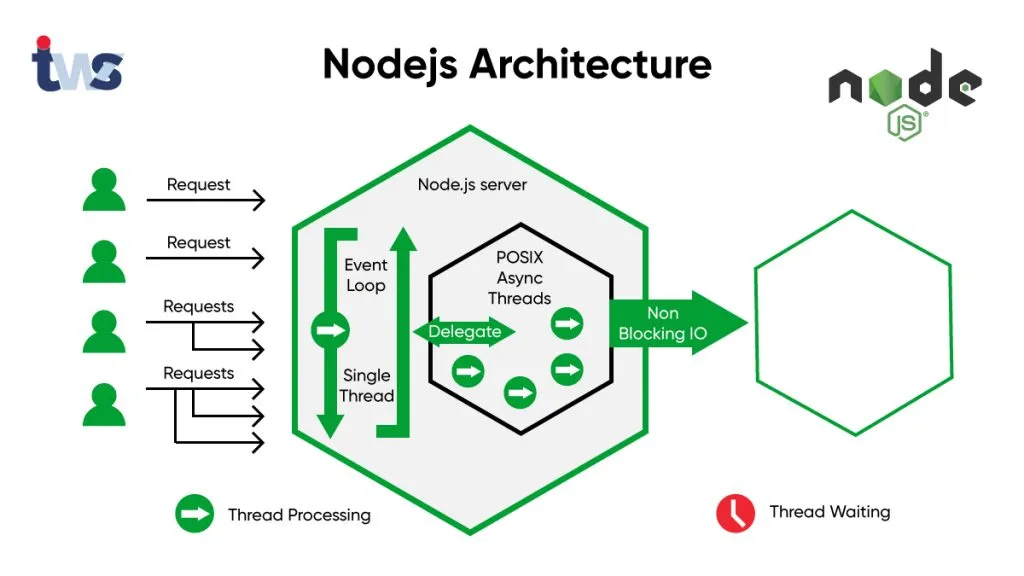Node.js is a powerful and popular JavaScript runtime that enables developers to build server-side applications with ease. Originally developed by Ryan Dahl in 2009, Node.js has since grown in popularity due to its speed, efficiency, and the flexibility it offers for building scalable web applications. In this post, we’ll explore what Node.js is, why it’s so widely used, and the diverse applications it supports in modern web development.
What is Node.js?

Node.js is an open-source, cross-platform runtime environment that enables JavaScript to run outside the browser, typically on the server. Built on Google Chrome’s V8 JavaScript engine, Node.js is known for its fast execution and efficient handling of asynchronous tasks, making it ideal for building scalable, real-time applications.
One of Node.js’s standout features is its non-blocking, event-driven architecture, which allows developers to handle multiple requests simultaneously. This quality is particularly advantageous when building applications requiring quick data retrieval, like real-time chat applications or streaming services.
“Node.js is much more than a runtime; it’s a platform that transforms JavaScript into a universal programming language for both client and server sides.”
Key Uses of Node.js in Web Development
- Real-Time Chat Applications
Node.js’s event-driven nature makes it highly suitable for real-time applications. Many chat applications leverage Node.js to handle multiple chat instances in real-time, enabling features like message broadcasting and private chats with minimal latency. - Data Streaming and Media Applications
Given its ability to handle large data streams, Node.js is commonly used for streaming services. It enables the transfer of data chunks, which is ideal for video platforms, streaming audio, and other applications that need a steady stream of data. - Single Page Applications (SPAs)
Node.js is frequently used in SPAs, which load once and allow user interaction without refreshing the page. This setup enables seamless user experiences and, combined with responsive design principles like those discussed in responsive design with Flexbox and Grid, results in visually appealing and efficient applications. - Backend for Web and Mobile Applications
As a backend runtime, Node.js provides APIs and database connections for mobile and web apps, enabling them to interact seamlessly with servers. When combined with strong frontend technologies like those highlighted in CSS3 Basics for styling web pages, Node.js helps create full-featured and cohesive applications.
Why Developers Love Node.js
- Speed and Performance: Node.js’s V8 engine compiles JavaScript directly to machine code, which boosts the performance and speed of applications.
- Large Ecosystem and Community Support: Node.js has a vast ecosystem of libraries available through npm (Node Package Manager), which allows developers to integrate modules quickly.
- Scalability: Due to its asynchronous nature, Node.js can handle thousands of concurrent connections, making it ideal for applications that require scalability and flexibility.
- Full-Stack Capabilities: Node.js empowers developers to work on both the front and back ends with the same language—JavaScript—simplifying the development and deployment processes, as demonstrated by services like deploying full-stack applications with Heroku and Vercel.
Getting Started with Node.js Development
Starting with Node.js is relatively easy, as it only requires installing the runtime and choosing a code editor. Once set up, developers can create web servers, APIs, and more using JavaScript. Building applications with Node.js becomes even more efficient with its numerous frameworks, such as Express.js, Koa, and Meteor.

Adding Value to Applications with Node.js
Node.js isn’t only for full-scale applications; it’s also excellent for enhancing existing ones. For instance, integrating Node.js with an existing website can improve data handling, enable better API management, and even introduce additional functionality without needing a complete overhaul.
In Conclusion
Node.js has become a crucial tool in the modern developer’s toolkit, especially for applications that require scalability, real-time data processing, and a strong frontend-backend synergy. From building high-performance SPAs to handling massive data streams, its versatility in web and mobile app development is well-regarded. When combined with frontend frameworks and responsive design principles, Node.js enables developers to craft applications that are both functional and visually appealing.
Whether you’re new to Node.js or looking to expand your backend capabilities, it’s clear that this technology offers a wealth of opportunities in today’s digital landscape.









